Pokhara: The City of Lakes
Pokhara is a beautiful city in central Nepal, known to the residents as the “City of Lakes.” Famous for its freshwater lakes of Phewa, Begnas, and Rupa with the beautiful reflections of the Annapurna and Machhapuchhre ranges, Pokhara is an adventure tourist town and gateway to mythological trek trails like the Annapurna Circuit. Pokhara is a required visit. Pokhara represents an opportunity to be close to beautiful nature and partake in outdoor activities, amid a gentle setting, unobjectionable scenery and cultural life.
Settled in the arms of the Himalayas, Pokhara captivates visitors with its natural beauty and tranquil atmosphere. There are 9 lakes of Pokhara, which comprise the Pokhara Valley Lake Cluster a Ramsar site of ecological importance.Among them, the most frequented one is Phewa Lake, painted boats and island temple drawing tourists throughout the year. Besides its lakes, Pokhara also has viewpoints such as Sarangkot and World Peace Pagoda that provide both the white-capped peaks with a daunting appearance.
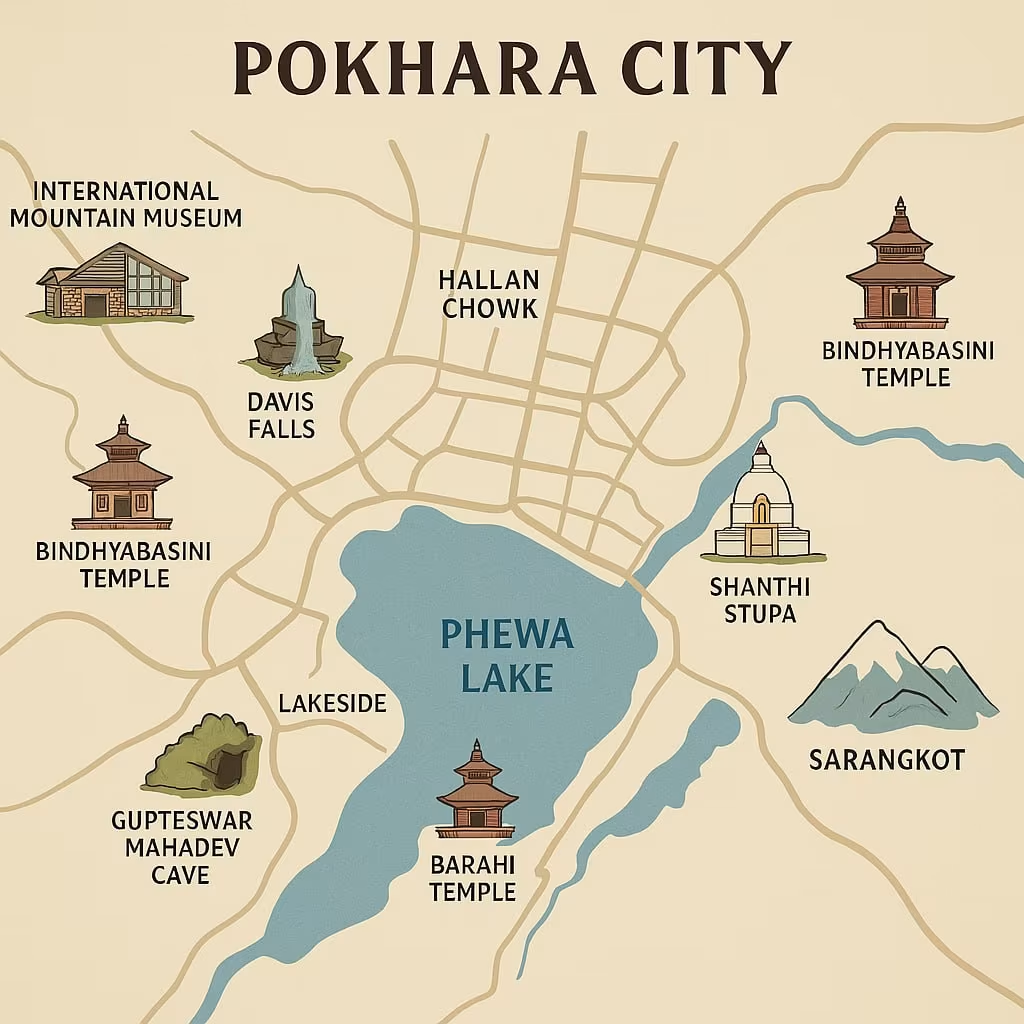
For thrill-seekers, Pokhara is a true mecca for adventure. With numerous options, including paragliding through the valleys or doing a rugged trek to Annapurna Base Camp, the options are endless. Pokhara is also very close to the mountains, where you can begin your hike toward either the Annapurna Conservation Area or the Mustang region.
You can also choose to visit a cave. Gupteshwor Mahadev is a great option, or perhaps you would like to take out a paddle boat on the water for a peaceful option. The city is very calm, but it also has countless options and amenities to keep you occupied such as cafes by the lake, cute boutique hotels, and numerous cultural options like visiting the many museums and temples around the city. Whatever you choose, if you like either refreshing experiences or relaxation, Pokhara will not disappoint.
Quick Facts To Know About Pokhara
- Location: Central Nepal, approximately 200 kilometers to the west of Kathmandu.
- Elevation: 822 meters (2,697 feet) high.
- Population: Around 599,504.
- Province: It is the capital city of Gandaki Province.
- Nicknames/Given names: Noted as “The City of Lakes” and “The Tourism Capital of Nepal.
- Noteworthy Lakes: Lakes, such as Phewa Lake, Begnas Lake, Rupa Lake, etc.
- Tourism/Attractions: Beautiful tourist places – World Peace Pagoda, Davis Falls, Gupteshwor Cave, International Mountain Museum and more.
- Adventureactivities: Paragliding, zip-lining, white-water rafting, and noting itself as a hub starting point for trekking routes (such as the Annapurna Circuit).
- Diversity of culture: Home of a diverse group of peoples – Gurung, Magar, Thakali descendants, etc – all having their values and forms of culture and norms.
- Weather/Climate: Mild weather conditions; hot summers (25°C) and generally dry winters (~7°C); the best time of year to visit is September to November.
Why Visit Pokhara?
Pokhara is Nepal’s top destination, where sporting adventure and nature beauty are combining very well with one another. The clean environment and peaceful atmosphere of Pokhara are a soothing balm to the humans suffering from the pace of city life.
Encircled by high snow-capped mountains and providing views of the whole Annapurna range of mountains, the beauty of Pokhara is simply breathtaking.
A paradise of adventure, Pokhara has the world at its feet. With the world as playground, the adventure capital of Nepal has endless possibilities, such as paragliding over the calm Phewa Lake, and white-water rafting on the handy rapids.
Zip-lining and mountain biking and even bungee jumping, with danger inherent for the willing participant, have also become more popular among adventure-seekers. Most of the trekking starting points in the region are at Pokhara as well, and it sees backpackers from all continents.
Aside from adventure, Pokhara also offers traditional culture. Its history and its people are seen in the structures of its temples, museums, and markets. It is possible to find the people, sample local Nepalese cuisine, and meet smiling and hospitable locals.
In one way or another, whether you are an action-seeker or looking for a relaxing vacation, Pokhara beckons and is an absolute must-visit for any traveler.
Best Time to Visit Pokhara
Selecting the right time to go to Pokhara will surely add flavor to your experience because the climate of the city changes according to the season. Each season has its beauty scene, energy, and activity, so Pokhara is always worth visiting at any time of the year.
But Spring (March-May) and Autumn (September-November) are employed most widely to refer to the optimal periods for visiting this beautiful city.
Spring (March to May)
Pokhara’s spring is pleasant and warm, with mean highs ranging from 26.7°C (80.1°F) in March to 29.8°C (85.6°F) in April. Conditions are generally bright and sunny, with a clear sight of the towering Annapurna range.
These are also the months when the loveliest rhododendrons and other valley flowers flower in flower in the coloring phase of the colors to create beauty to cover up the duller green. These are the best months of spring for leisure sports like boating on the Phewa Lake, paragliding, and trekking because they provide fine weather conditions.
Autumn (September to November)
Autumn is the busiest tourist season in Pokhara. The weather is dry following the monsoon, and the sky is crystal clear, providing breathtaking panoramic views of the Annapurna range with snow-capped peaks.
The climate is still nice during this time of the year, and the temperature ranges from 15°C to 27°C, which is highly appropriate for excursion activities. Phewa Lake is full to the brim, perfect for boating or a walk along the lake.
Additionally, two of the biggest festivals of Nepal, Dashain and Tihar, fall during this duration, and the tourists can have a glimpse of the local culture.
Other Seasons
- Summer/Monsoon (June to August): It rains heavily during this period, so there is a lot of greenery but also wet and rough trek trails. The extremely high incidence of rain can spoil mountain views, and leeches are common on trek trails. The absence of tourists, however, may be a draw for those who do not enjoy too many tourists.
- Winter (December to February): Winter is cool, with temperatures between 8°C (46.4°F) and 20.7°C (69.3°F). Blue skies and clear mountain views continue, but the chill in the air might be less appealing to some. Less crowded during these months provides a more peaceful atmosphere.
In short, though Pokhara’s beauty is omnipresent, scheduling your trip either in spring or autumn will afford the best weather and the greatest possibility to see the city’s natural beauty and cultural life at its fullest.
Pokhara Valley Climate, Temperature and Weather Considerations
| Month | Avg. High Temp (°C) | Avg. Low Temp (°C) | Avg. Rainfall (mm) | Rainy Days | Avg. Sunshine Hours |
| January | 17.3 | 3.1 | 22 | 2 | 6.7 |
| February | 19.2 | 3.8 | 31 | 2 | 6.7 |
| March | 24.5 | 8.8 | 53 | 2 | 8.2 |
| April | 28.1 | 12.7 | 91 | 3 | 9.6 |
| May | 29.0 | 15.9 | 194 | 5 | 7.3 |
| June | 29.1 | 18.6 | 342 | 11 | 6.3 |
| July | 28.4 | 19.7 | 479 | 16 | 4.0 |
| August | 28.0 | 19.7 | 405 | 15 | 4.0 |
| September | 27.3 | 18.2 | 275 | 10 | 5.0 |
| October | 25.3 | 13.7 | 89 | 3 | 6.9 |
| November | 22.1 | 7.9 | 12 | 1 | 6.7 |
| December | 18.4 | 4.0 | 19 | 1 | 6.3 |
How to Reach Pokhara
Pokhara, Nepal’s stunning “City of Lakes,” is available by almost any means of travel you can imagine, each having something to give and to enjoy. If you love flying and the convenience that comes with it or scenery that surrounds the ride with a healing touch, the following are within your convenience:
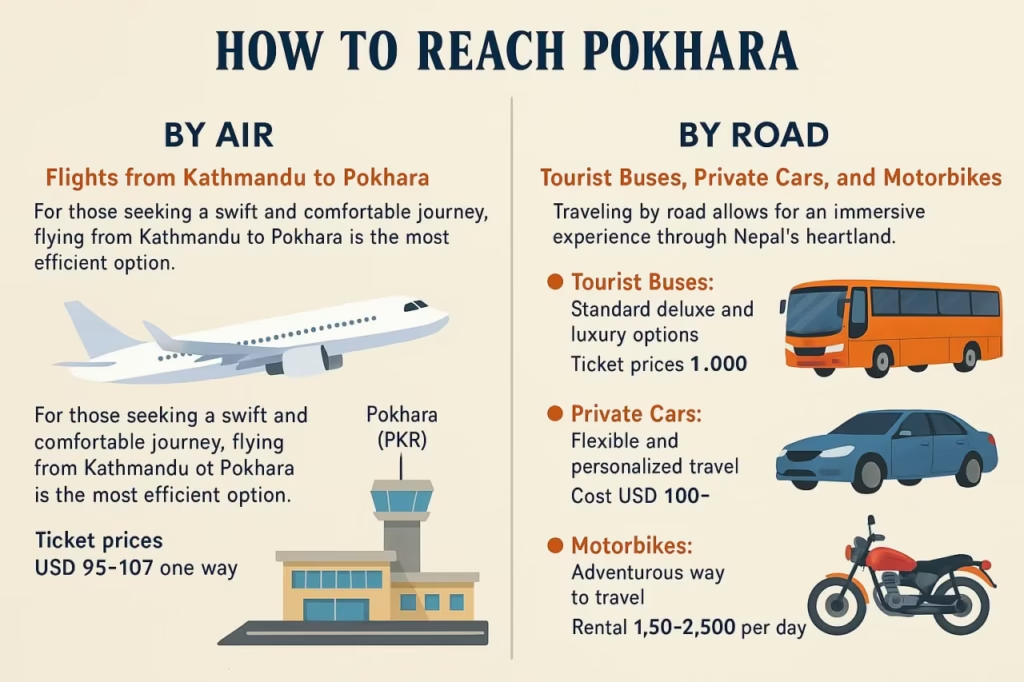
By Air: From Kathmandu to Pokhara fly.
For unbothered and busy tourists, the most convenient and quickest method is by flight from Pokhara to Kathmandu. Regular routine services are flown by national airlines from Tribhuvan International Airport at Kathmandu (KTM) to Pokhara Airport (PKR). The 25 to 30-minute flight provides the best view of the Himalayan mountain range and diversified Nepalese landscape.
Round-trip airfare typically costs between USD 95 and USD 107, depending on airlines and reservations. Advance reservation, especially during holidays, is prudent as a precaution to secure good flight times and rates. The traveler should also be aware that at times weather may be a cause for flights to be canceled or delayed.
By Road: Tourist Buses, Private Cars, and Motorbikes
The road trip from Pokhara to Kathmandu is one of spectacular Nepali landscapes, depth of nature, and cultural experiences. It is a 200-kilometer drive lasting 6 to 8 hours depending on traveling and road conditions.
Tourist Buses: Ideal for travelers, tourist buses are the best of both comfort and price. Tourist buses depart at about 7:00 AM from Kathmandu’s Sorakhutte and move at a slow pace to reach by afternoon in Pokhara.
They vary from regular deluxe buses to luxury VIP sofa buses, with features varying from air-conditioning and reclining seats to in-transit refreshments.
Prices vary as the normal buses will charge NPR 1,200 and the deluxe NPR 1,600. Pre-booking one day in advance is necessary, especially while traveling during peak season.
Private Cars: Private cars can be reserved for people who do not mind traveling alone and are comfortable. Traveling in a car is approximately 5 to 7 hours depending upon traffic and road conditions.
Also, a private car transfer can be arranged, and this usually costs between USD 100 and USD 150 for a three-passenger trip, and this is a good option for families or groups who require a bit of privacy.
Motorbikes: Motorbikers have the choice of taking a motorbike as an exciting mode of traveling within Nepal’s diverse geography. One may hire a motorbike for a day in Kathmandu at a day’s average rate of NPR 1,500 to NPR 2,500 depending on the type of the motorbike.
The road from Pokhara to Tansen is a mix of bad road and bitumen with patch-up work and will give us another 7.5 hours or so of bike time. The riders will need to be well equipped to handle the road conditions and should have the correct permits and safety gear.
All modes of transportation are all Nepali landscape and cultural experiences. With regard to speed, convenience, or adventure, any one of the options chosen can be undertaken depending on whatever is most convenient by necessity and time suitability.
Top Attractions in Pokhara
Phewa Lake
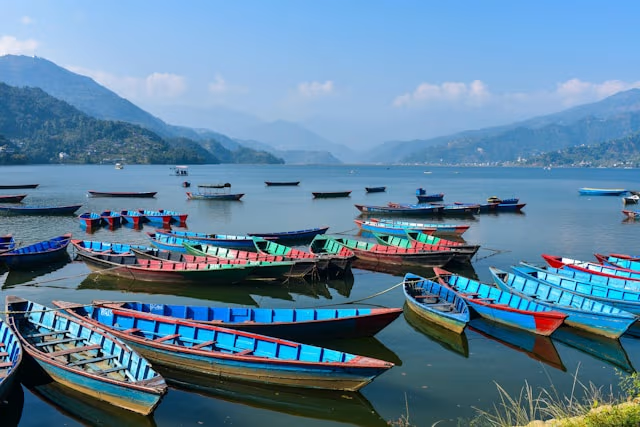
Nepal’s second-largest lake is Phewa Lake, and it is the crown jewel of Pokhara’s natural beauty. An easy boat ride, either by going on an organized tour or by hiring a colorfully painted paddle boat, can be undertaken to glide over the calm waters of the lake and catch a glimpse of the Tal Barahi Temple, which is located on an island in the middle of the lake.
The lake walk is bordered by a row of restaurants and cafes from local to international, and so it is the ideal place to relax and enjoy the stunning views. Evening catches the lake painted with hues of the most gorgeous sunset as the Annapurna range is mirrored on its glassy surface.
World Peace Pagoda

The Shanti Stupa, also known as the World Peace Pagoda, symbolizes peace and harmony located on a hill quite high above Phewa Lake. Visitors have to hike a moderate to steep trail to the stupa. The hike itself is enjoyable while walking and watching many various birds and the changing conditions. When visitors arrive at the top, they are rewarded with stunning views of the Annapurna mountain range, Phewa Lake, and the Pokhara Valley. The stupa is white and dome-shaped; it is a lovely, peaceful place for people to pray and reflect.
Sarangkot
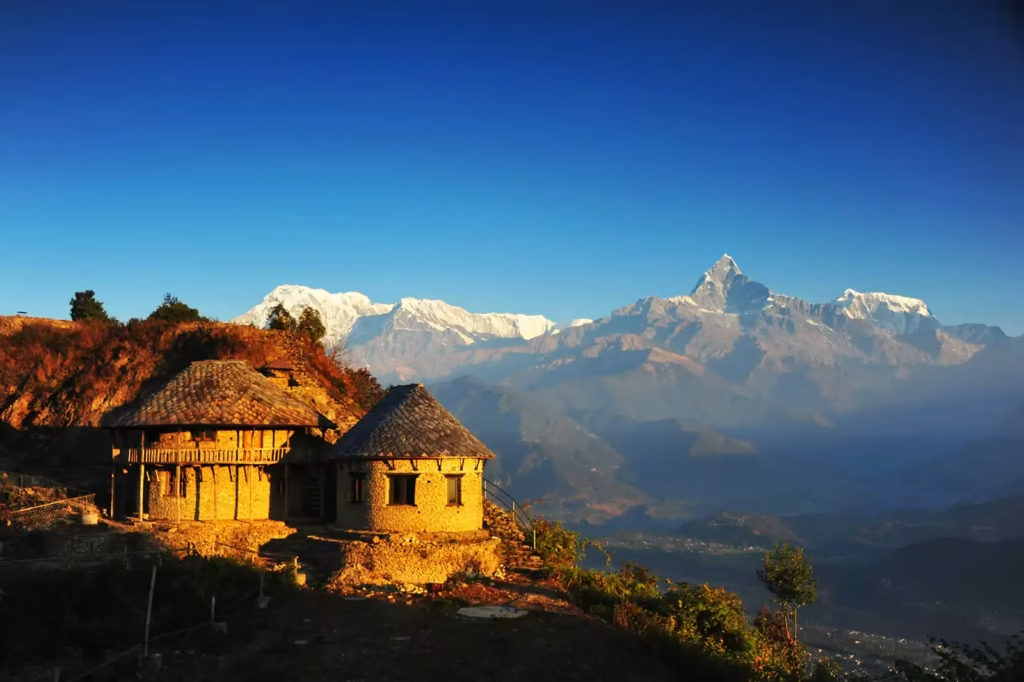
Sarangkot is famous for offering stunning sunrise views in Nepal. Sunrise excursion takes the visitor to the viewpoint, where they can watch the first rays of sunlight kissing the peaks of Dhaulagiri, Annapurna and Machhapuchhre. In addition to its morning beauty, Sarangkot is the best place to take off for paragliding. The weather and view from Sarangkot is arguably some of the best in the world, and flying above Pokhara adds to the thrill.
Davis Falls & Gupteshwor Cave

Davis Falls or Patale Chhango is a unique falls that drops into an invisible underground tunnel, offering a great sight, especially during monsoon when water levels are richest.
Right opposite the falls is the Gupteshwor Mahadev Cave, a spiritual underground temple holding a sacred Shiva lingam. A journey into the cave reveals you to beautiful rock formations and an aura of adventure as you navigate through its dark interiors.
The marriage of the deafening waterfall and mystical cave places this destination on the must-visit list for nature and culture enthusiasts.
Begnas & Rupa Lake
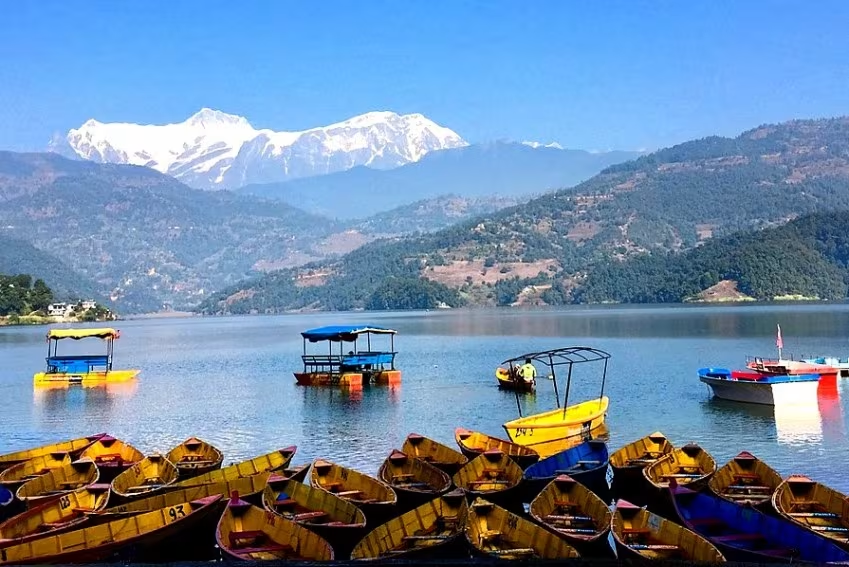
For those who seek peace away from the crowd of tourist destinations, there are peaceful retreats in Begnas and Rupa Lakes. Begnas Lake, on the outskirts of Pokhara, is famous for its untouched and peaceful environment, and the Annapurna range acts as a backdrop of glory.
Right next to it lies vast, unexplored Rupa Lake, so nature can be enjoyed by people in its natural form. Both lakes permit boating, fishing, and just walking around their shores, so they are ideal places where one can spend their free time and watch birds.
Adventure Activities in Pokhara
Paragliding
Quick Facts
- Price: $80–$120 (30–60 min flight)
- Where: Sarangkot Hill (launch point)
- Best Time: October–March
- Operators: Blue Sky Paragliding, Avia Club Nepal
Pokhara is known to be one of the best places in the world to paraglide and fly tandem with a certified pilot. You fly over the sparkling waters of Phewa Lake and soar above the edges of the Annapurna range, while also gliding alongside Himalayan eagles.
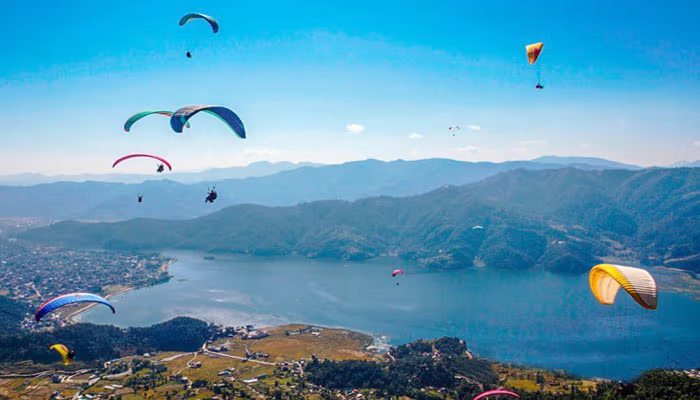
The benefit of the morning flights is the wind being calm; flying is relaxing.
The afternoon flights can be exhilarating, providing thermals and free flights. You’ll have the chance to capture action GoPro views of terraced farms and local villages tucked below you.
This is an excellent option for those looking for their first experience in paragliding, as the experienced pilot manages all takeoff and landing.
Paragliding is all about the calmness, views, beautiful aerial experiences, along with splashes of excitement and thrills. Check this off your list of adventures when you come to Pokhara!
Trekking
Quick Facts
- Price: $20–$50/day (guided treks)
- Routes: Annapurna Base Camp, Poon Hill
- Best Time: March–May & October–November
- Permits: ACAP ($30) + TIMS ($20)
Pokhara is the gateway to legendary treks in the Annapurna Conservation Area. Trails wind through rhododendron forest, Gurung villages, and above-glacier altitudes. Multi-day treks include nights in family-run teahouses with dal bhat and ginger tea.
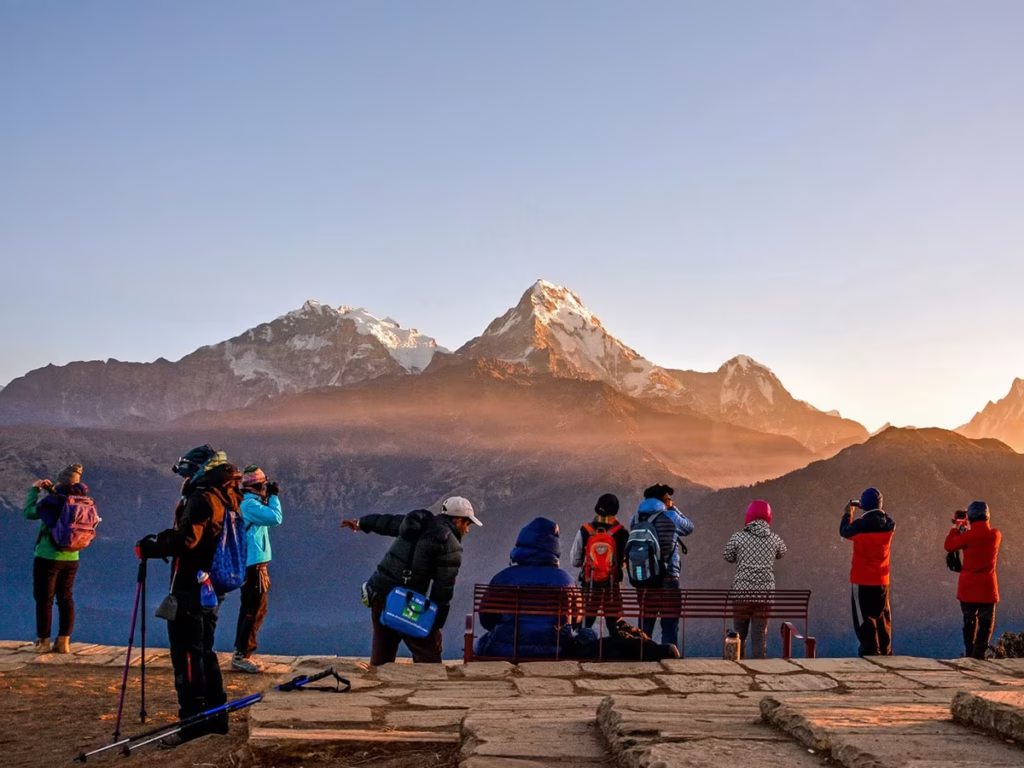
The Annapurna Base Camp trek reveals close-up views of Machhapuchhre, while Poon Hill offers classic sunrise views. Alternatives include easy 3-day walks or challenging 2-week expeditions.
Himalayan landscape and cultural experience reciprocate their dependence on each other and present themselves before inexperienced and seasoned adventurers alike.
Boating (Phewa Lake)
Quick Facts
- Price: $3–$10/hour (paddle boat)
- Location: Lakeside area
- Best Time: Sunrise or sunset
- Extras: Visit Tal Barahi Temple
Pristine waters of Phewa Lake mirror Machhapuchhre peak looming above to capture Nepal’s most iconic picture. Rent colorfully painted wooden boats to sail secluded coves or paddle circles around island-fringed Tal Barahi Temple.
Kayaking routes trace waterfalls and scenic fisherman villages. Gentle light and town lights on the shores capture sunset journeys.
Kids and adults relax throughout the process, while cameras snap images of Annapurna range reflections. Tranquil lake environment offers peaceful retreat for Pokhara adventure sports enthusiasts.
Bungee Jumping
Quick Facts
- Price: $70–$90/jump
- Height: 80m (Asia’s 3rd highest)
- Location: Hemja (20 mins from Lakeside)
- Operator: The Last Resort
Bungee jumps from the 80-meter tall platform into the Kali Gandaki Gorge surrounded by Annapurna foothills. Two couples or friends can enjoy it together with tandem jumps.

Most experienced operators use full-body harnesses and elastic ropes for smooth bounces. Canyon swings over the terraced fields after the 4-second freefall. Mid-air smiles are recorded by professional cameramen.
Complimentary snacks after the jump to relive the experience. It is for adventure-seekers out there who seek adrenaline-filled trips in the midst of Nepal’s finest landscapes.
White-Water Rafting
Quick Facts
- Price: $40–$70 (half/full day)
- River: Seti (Grade III rapids)
- Best Time: September–December
- Includes: Lunch + safety gear
Drift through the rapids of Seti River through jungle-forested canyons and villages. Half-day rafting provides spine-tingling Grade III runs, while family rafting stretches provide sand beach picnics.
Include cliff jumping or canyoning for an additional adrenaline boost. Local ecology commentary by local guides is provided alongside safety. Winter rafting provides cold waters and smaller numbers of tourists.
The trip balances thrill with calm floats through fishermen’s villages and rice paddies. Unwind later over masala tea in riverbank resorts.
Zip-Lining
Quick Facts
- Price: $50–$70/ride
- Length: 1.8 km (Asia’s steepest)
- Speed: 120+ km/h
- Location: Sarangkot base
Zip along Asia’s steepest zip-line at over 120 km/h through jungle. Side-by-side, double-cable riding offers competitive thrills. The 1.8 km run stretches from Sarangkot hills to the bottom of the valley, with a glimpse of Annapurna midway through the zip.
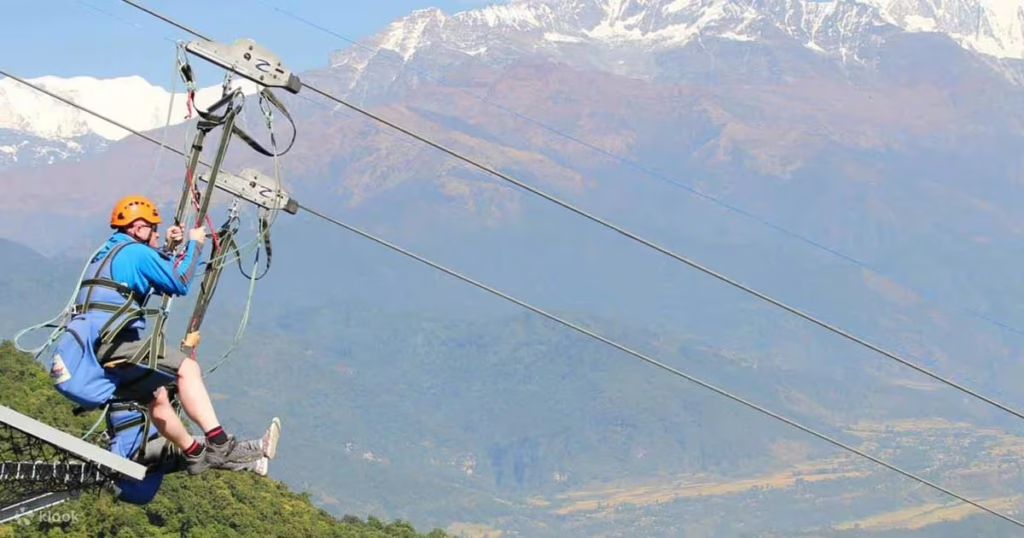
Safety harness and helmets are worn throughout the 2-minute flight. Early morning time slots mean less wind for a smoother flight. Photo packages capture your in-flight smiles.
The ride is a pure adrenaline rush with Himalayan scenery, an adventurer’s bare essentials.
Mountain Biking
Quick Facts
- Price: $10–$30/day (bike rental)
- Trails: World Peace Pagoda loop, Begnas Lake
- Difficulty: Easy to expert
- Guides: $25–$50/day
Ride through terraced farms, Buddhist stupas, and lakeside trails in Pokhara. Hardtail bikes are fine for pedaling along dirt roads to the World Peace Pagoda, but e-bikes will get you to Sarangkot in much less time.
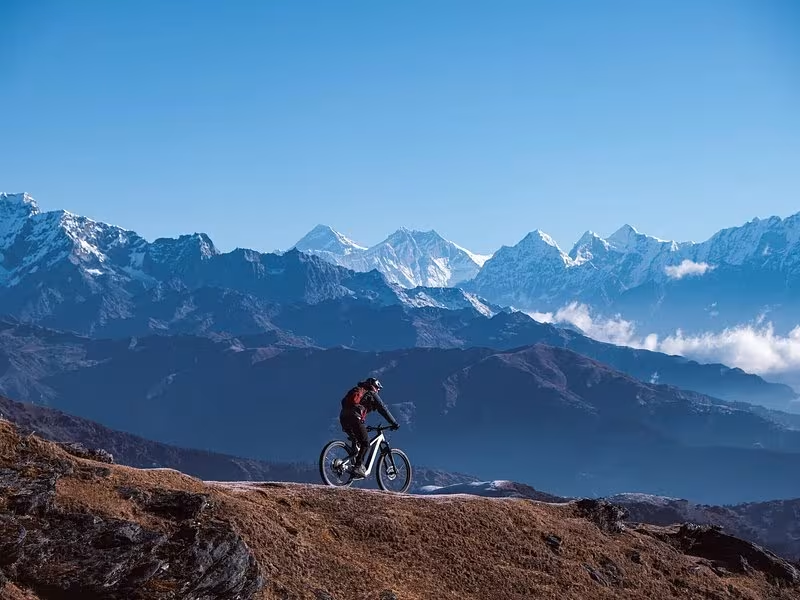
Longer tours will take you to Tibetan refugee camps and waterfalls that you would never otherwise have seen. Having a local guide ride with you to give some cultural context or to point out the flora and fauna is great.
For example, take a ride in the morning when the mountains are usually shrouded in mist or in the evening when food stalls are set up at the bazaar.
You will enjoy cycling in Pokhara for the mix of exercise and cultural discovery which will be an experience to cherish for the physically active while traveling.
Caving
Quick Facts
- Price: $3–$5 entrance fee
- Caves: Gupteshwor Mahadev, Bat Cave
- Best Time: Oct–Apr
- Tip: Wear slip-resistant footwear
Pokhara’s limestone caves, Hindu temples, and underground waterfalls beckon the explorer. The Gupteshwor Mahadev Cave houses a sacred Shiva lingam and tunnels to Davis Falls’ view point.
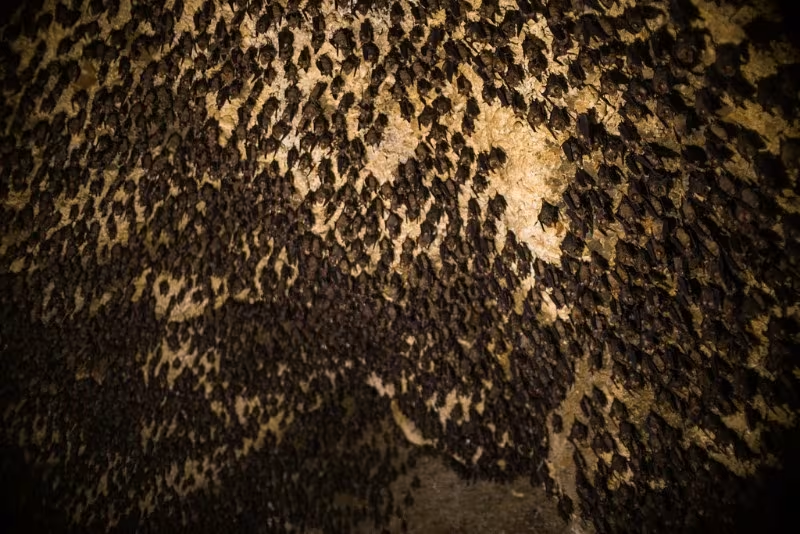
The Bat Cave is a host to thousands of fruit bats, who fill the dusk skies with headlamp accompaniment. Elbow-width tunnels challenge agility, and large, well-lit caverns spill onto the stalactite and stalagmite.
Guides offer geologic history and local lore. Cool, dark interiors are havens from the noonday sun, providing adventure along with spiritual and natural beauty.
Hot Air Ballooning
Quick Facts
- Price: $200–$300/person
- Duration: 1–1.5 hours
- Capacity: 4–8 passengers
- Operator: Balloon Nepal
Drift effortlessly above Pokhara Valley at daybreak, enjoying amazing views of the Annapurna range catching the first light of dawn. Flights are paired with champagne breakfasts and often served in beautiful meadows.
The basket provides a 360-degree view of Phewa Lake, terraced farms, and old villages; the pilots share stories of the geology and cultural history of the Himalayas. It is a romantic experience, and perfect for proposals and anniversaries.
You will be in good hands; with an excellent certified crew, and modern equipment. Winter flights are phenomenal too, with the snow-capped mountains standing in front of an amazing blue sky.
Ultra-Light Flights
Quick Facts
- Price: $150–$250 (15–30 min)
- Location: Pokhara Airport
- Best Time: 7–10 AM
- Views: Annapurna Sanctuary, Fewa Lake
Ultra-light aircraft, flown by a pilot, are able to fly practically to the ridgelines of Machhapuchhre, providing phenomenal views of this segment of the Himalayan area. Often GoPro mounts put on the ultra-light allow one to click aerial photos and video of remote valley villages, waterfalls, and forests.
The flights, usually in the winter, typically are in the mornings and due to the low-angle sunlight, there are often brilliant outlines of the mountains against a very blue sky.
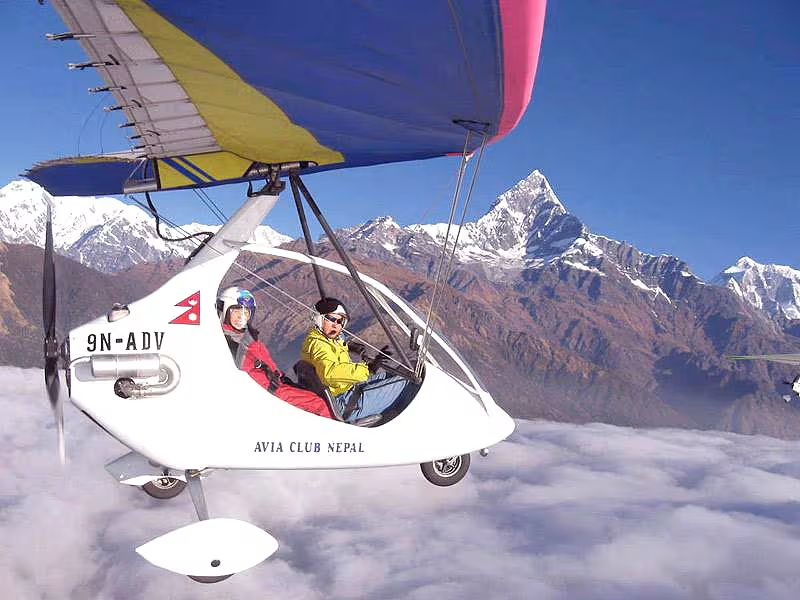
The open cockpit (in verified safe flying conditions) allows for the winds to sweep through and the very sound of the engine, adds to the adventure aspect of more than just flying.
Before the flight, there is a brief talk about safety protocol, thus everyone makes notes of the significant safety protocols and flight plans, and highlights aspects of scenic views for the flight.
Everything about the experience is a bucket-list experience for many, and demonstrates the wonder of flying to take photographs of Nepal that would not be available from the ground.
Canyoning
Quick Facts
- Price: $60–$90 (half-day)
- Location: Seti River gorges
- Includes: Gear + guides
- Best Time: September–November
Descent a waterfall or rocky gorges while secured in rope and harness. There are 10-15 meter descents, natural slides, and plunge pools to experience in the canyons of the Seti River.
Experienced guides and teaching techniques always provide safety. Combine with jumping off a cliff for even more adrenaline. Pictures and snacks are typically included at the end of your tour.
This is an ideal activity to do as a group if you’re looking to have some fun in the water that Pokhara is known for while being around green forests, trees and grasses.
Kayaking
Quick Facts
- Price: $20–$50 (guided tours)
- Location: Phewa Lake or Seti River
- Types: Lake kayaking (calm) / river kayaking (rapids)
- Best Time: October–April
Enjoy the calm for Paddle Phewa Lake or the thrill of Class II-III rapids along the Seti River.
Tours of the lake float past secluded coves and temples on island parks, while the river provides thrills with drops that get your adrenaline going, followed by flats to relax.
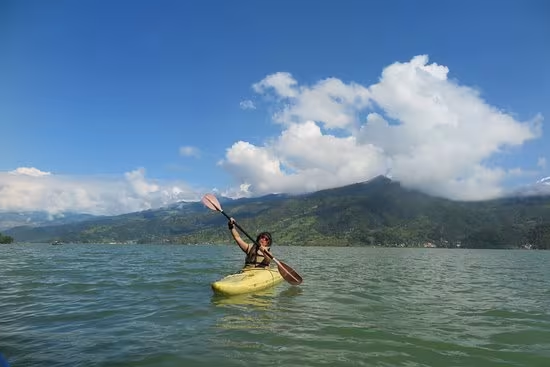
New to paddling? You can learn all the basics strokes from professional, certified guides and coaches. Sunset kayaking on Phewa Lake mirrors the surrounding mountains!
With dry bags for your cameras, you’ll get a chance to photograph the kingfishers and water buffalo which line the banks of the river.

